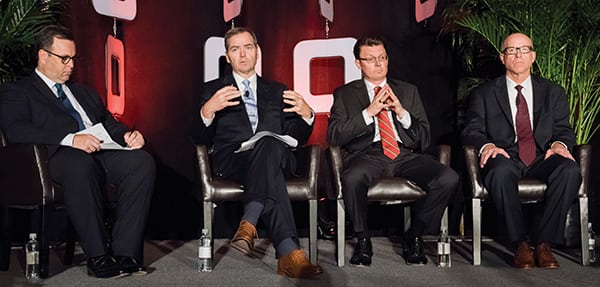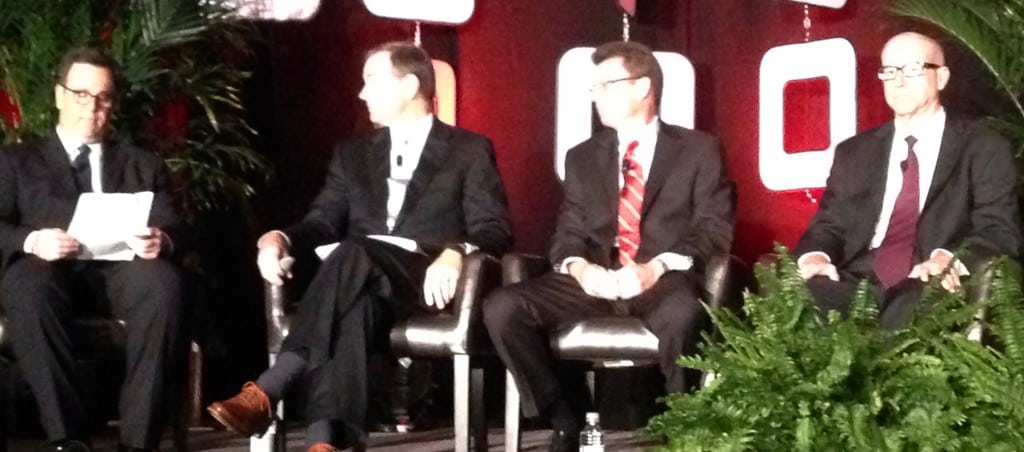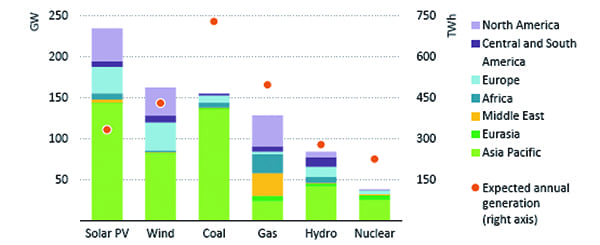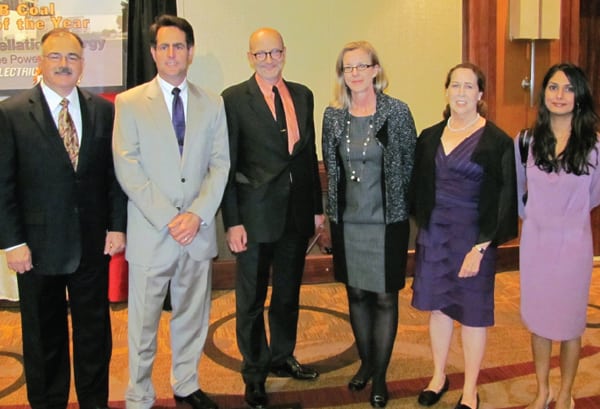The U.S. power sector is in a state of flux, grappling with cheap natural gas, pressures to achieve fuel diversity, the integration of distributed energy resources, and nearly nonexistent demand growth. Executives from power companies operating in different markets shared how they are tackling these challenges.
The annual panel discussion by high-level leaders from diverse power companies is a cornerstone of the ELECTRIC POWER Conference & Exhibition, and it has been consistently emblematic of the state of the U.S. power sector. It was no different this year, at the 18th annual event in New Orleans, La.
Titled “Industry Makeover—The New Face of the Power Industry,” the Executive Roundtable discussion on April 19 was moderated by Richard McMahon, vice president of energy supply and finance for the Edison Electric Institute (EEI). Panelists were Phillip May, president and CEO of Entergy Louisiana; John Trawick, senior vice president of commercial operations and planning for Southern Co.; and Clarence Hopf Jr., senior vice president and chief commercial officer for the newly formed Talen Energy (Figure 1).
Flat Demand Growth
Change was the overarching theme of the discussion. The industry is in a state of flux, the three panelists agreed, most of which could be pegged on market shifts. Affecting all markets uniformly is the nation’s slack electricity consumption: Total electricity sales in 2015 fell 1.1% from the previous year, marking the fifth time in the past eight years that sales have fallen, the Energy Information Administration said in March. Declining rates of electricity demand growth—despite growth in the number of households and growth in commercial building space—reflect a combination of factors, including market saturation, increasing efficiency of electricity-using equipment, a slowing rate of economic growth, and the changing composition of the economy, which has reduced the role of electricity-intensive manufacturing.
For Entergy Louisiana, Entergy Corp.’s subsidiary that serves about 1.06 million customers in the state, the story is a little different, said May. While Louisiana is generally seeing high industrial growth on the Gulf Coast—driven by low natural gas and feedstock prices—the utility, like the rest of the nation, is seeing flattened residential and commercial customer usage that can be attributed to the effect of “energy efficiency and sufficiency,” he said.
Even so, Entergy Louisiana is building new generation to replace its aging fleet, roughly half of which was built before 1995. “Those plants can now be replaced with more efficient plants,” May added, noting a proclivity for natural gas combined cycle gas turbines (CCGTs). “So we are now embracing plants that may have heat rate close to double in terms of efficiency of operation. There’s a smaller number of people required to manage that plant, and in terms of operating costs, more predictable operating costs.” The new plants can also be added with “relatively little impact on a customer,” he said.
Entergy Louisiana, along with Entergy’s other utility operating companies, only completed its integration with the Midcontinent Independent System Operator (MISO) in December 2013. That move has saved billions of dollars, the company says, largely attributable to MISO’s organized power markets that allow for more efficient commitment and dispatch of generating plants. Savings also derive from the economies of scale offered by a regional transmission organization of MISO’s size and MISO’s transmission cost allocation methodology, which “equitably allocates the costs of transmission projects to those receiving the benefits from those projects.”
Southern Co., a largely regulated business, is supportive of customer energy efficiency efforts, said Trawick, pointing out that the company also has the added benefit of having a “good diverse fleet of assets” and “the ability to switch fuels in the real term based on what gas and coal prices tell us.”
But for Talen Energy, the dismal demand outlook is more insidious, Hopf suggested. The firm, one of the largest independent power producers in the U.S., was established only a year ago, in June 2015, as Pennsylvania-headquartered PPL Corp.’s competitive power generation business spun off and combined with the competitive generation business owned by private equity firm Riverstone Holdings LLC.
Talen’s president and CEO, Paul Farr, has described the firm as a “pure-play competitive energy company,” noting that most of its highly diverse merchant fleet of about 16.8 GW is primarily located in two of “the largest, most transparent, and most liquid competitive markets in the U.S.”—PJM and the Electric Reliability Council of Texas (ERCOT). In Texas, a market that ERCOT chiefly serves, growth is soaring, but in the Northeast, growth is being offset by subsidized resources such as energy efficiency and combined heat and power plants, Hopf said. “It’s not that we don’t support those, but we think they need to be evaluated on the same level as other resources,” he added.
Distributed Energy Resources—Help or Hindrance?
Also affecting all markets is the emergence of distributed energy resources (DERs), smaller sources such as energy storage, renewable technologies, and demand response that sometimes can be aggregated to address changes in demand. (For more on DERs, see the May 2016 issue of POWER.) For all three panelists, a key contention concerned subsidies that are driving mass rooftop solar installations.
May lauded Louisiana’s measures to slash subsidies to residential solar in an attempt to close its more than $1 billion budget chasm that has recently widened due to sinking oil revenues. While he acknowledged that the cost and economics of solar have improved drastically, he proposed solar was better deployed at utility scale. “As we go through this, the subsidies need to be reexamined at a state level, particularly when they get so large as to threaten a state’s budget,” he said. “We need to make sure we get the rules right on the rates that are being paid for the generation of solar. For instance, why would it be appropriate to pay a retail rate for electricity generated on a rooftop solar installation at a residential level when [rates for] a similarly large-scale [installation] would be half, or less than half of that?”
Trawick agreed that rate structures are crucial. He summarized the dilemma this way: “If you don’t get the rate structures right, you do end up with the same subsidy-type issue, as you’ll have one set of customers paying for a separate set of customers who decide to go a separate route.” That said, however, he underscored that Southern Co. looks at distributed generation as an opportunity for revenue growth associated with loads. “We want to be the one to provide that service to [those customers],” he said, adding that his company had in February moved to acquire PowerSecure, a developer of interactive distributed generation power systems that have the ability to forecast demand and electronically deploy systems at peak power times.
Panelists also agreed that energy storage hasn’t yet reached its zenith. May declared that unless Entergy sees significant breakthroughs on storage, “it’s simply not economic and likely won’t be economic for some time to come.” Likewise, Hopf predicted that storage may thrive in regional pockets, but not necessarily for Talen. “I think that to get that on the big scale, to do it economically, to do that competitively, we’re still many years down the road,” he said.
Fuel Diversity Is Not So Easy
Considering that their companies serve distinct markets in regions with varying energy needs and fuel resources, it was no surprise that the panelists were divided over whether fuel diversity should be prioritized over capitalizing on currently cheap natural gas.
Hopf accepted that a dependence on gas means “setting ourselves up as an industry” for disaster during events like the 2014 polar vortex. But the options are distorted, he said. “In the merchant competitive markets, you will see coal fleets and nuclear plants challenged—there’s just no way around it, unless someone can see in the foreseeable future [that] gas is going to make a significant upward trend.”
During the 2014 polar vortex incident, fuel diversity was indispensable, Trawick countered, revealing that Southern Co. saved customers more than $100 million that January by switching from gas back to coal when gas prices surged. Yet he cautioned that maintaining fuel diversity in current circumstances isn’t as easy as it sounds. “The world we’re entering into is very different, and to maintain that diversity, we’re going to ask the plants to do things differently than they may have done years ago,” he said. “We have to have a coal fleet that’s going to be more responsive than it was built to be,” even if “they weren’t built for all this cycling wear and tear.”
Entergy is a vertically integrated utility that operates in both organized markets and merchant markets, and May agreed that fuel diversity is important. But pricing is a big hurdle to achieving true fuel diversity, he said, because organized markets aren’t adequately paying plants for being emissions-free or for their flexibility. “I know that in MISO, we’re looking at new pricing initiatives, including looking multiple days out, so you can gain some of that ability for less-flexible plants, and you can get past that startup cost.”
The Case for Gas
Markets are also determining what kind of plants are being built. “I applaud Southern Co. for leading on building nuclear plants… but from an Entergy perspective, we just can’t go for it with a nuclear plant with where gas prices are right now,” May said, noting that Entergy had started down the path to new nuclear, but as gas prices fell, the company decided to push forward with new CCGTs instead.
“The costs of building a new CCGT, not only are they low, but they are quite sure, so the risk of building a plant—you have to get this through a regulatory process—it is just well-defined. Generally, when we are building a CCGT, we’re setting out how long it will take and how much it will cost, and generally we’re building it in a shorter time-frame and under budget.”
To offset price volatility, like several other U.S. utilities (Trawick noted that Southern is in the process of merging with AGL Resources), Entergy is looking at acquiring “gas in the ground,” and Louisiana regulators have opened a docket to investigate that, May revealed. He joked: “I’ve heard it said, and I believe it, that the world is round because it’s full of gas.”
Hedging to Ease Price Surprises
To guard against unexpected natural gas price spikes, many utilities also do some sort of hedging of fuel as a means of price protection to essentially “lock in” a price for natural gas (or coal) using a financial instrument—typically with a commodity futures contract, noted McMahon, whose organization represents the bulk of the nation’s investor-owned utilities. Regulators are taking an increasingly serious look at hedging in the face of a series of severe natural gas spikes.
Asked where their companies foresee regulation going with respect to hedging, May predicted that unless interference causes markets to morph, gas prices would remain low. He also explained that Entergy Louisiana is limited to short-term hedging—suggesting long-term contracts aren’t as reliable—but that has proved cumbersome because the company is a large buyer of natural gas. “Again, that’s why we think gas in the ground is a real opportunity.”
Trawick observed that, despite current low gas prices, he has heard “more talk of getting out of fuel hedging versus getting into fuel hedging—which is completely upside down.” He suggested that could be because of the way it is accounted for: When gas prices fall, they show up as financial losses. “And when those financial losses show up from a hedging standpoint, it’s very easy to react and say, ‘That was a bad decision,’ ” he noted. The utility business is moving toward acquiring gas assets, which have myriad benefits, among them that it firms up supply for customers, he said.
In the Shadow of the Clean Power Plan
A deeper shade of uncertainty is being projected on the industry by the Environmental Protection Agency’s Clean Power Plan, which has been stayed by the Supreme Court, panelists all suggested. During a discussion of how the companies are making long-term capital decisions in the face of the rule, most panelists agreed that even if the rule doesn’t pass legal muster, future carbon constraints are almost certain.
“Obviously, we’d prefer to see something that is more in the posture of a national energy policy of sorts,” Trawick said. That way everything is accounted for, “not just what’s clean, but also what’s affordable and reliable for customers.” One glaring issue for Southern, which operates in several states, is that “it creates challenges for us in wholesale markets,” he said. “How do you implement this sort of program when states can go different routes for compliance, and how will that impact the wholesale market?” he asked.
From the perspective of a company operating in an organized competitive market, Hopf decried state interference with markets, warning that when “carbon comes into play,” it is unknown whether states may or may not consider deals with power companies to bolster nuclear plants. He pointed to FirstEnergy and American Electric Power’s eight-year contracts with the state of Ohio that subsidize power plant operation even though, “economically, they can’t survive.” (Since this roundtable discussion, on April 27, the Federal Energy Regulatory Commission blocked those subsidy agreements.)
Entergy Louisiana’s total carbon emission output technically already complies with the rule, May said. But even that is uncertain because the state has yet to draw up its compliance plan. Depending on the price of carbon, banking on natural gas may still be the company’s best bet, he said. “The issue that needs to be worked out is from a regional basis—how do we collaborate on a regional basis so that all the compliance costs can be in the middle?” he asked. ■
— Sonal Patel is a POWER associate editor


















